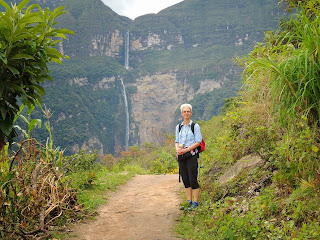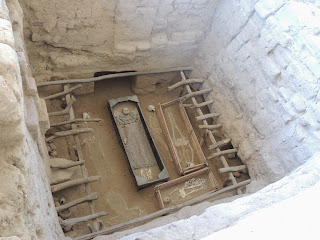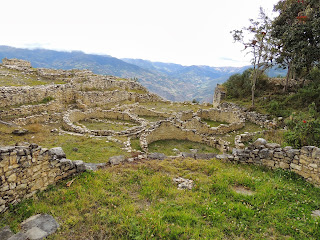Vic's Big Walk and Other Books
I walked, at the age of 70, almost 2,000 kms from the Pyrenees to Northern England. My book - "Vic's Big Walk" – is about the walk - and much else besides. "Living In The Real Cyprus" - quickly followed. Both books are now available in both e-book form and in paperback. The walk raised funds for Pancreatic Cancer research. Just click the blue donate button. All proceeds of all books go direct to the same cause. See below to read about my new fundraising project, Vic Talks The Walk
Tuesday, November 11, 2014
Now Talking The Walk
This blog has now finished. There will generally be no new posts.
But you may be interested in looking at my new blog "Vic Talks The Walk". This will chronicle my project to raise further funds for pancreatic cancer research by travelling around, giving talks to clubs and other interested bodies.
The talks will be about my Big Walk project, from inception to completion 14,500 kms later, I have already done several of these talks to groups of English speakers in France, where they were a great success. The fundraising bit comes at the end of the talks, not with a "whip-round", but sales of autographed copies of my books. There is no obligation to buy.
Take a look at Vic Talks The Walk by clicking HERE
Monday, November 4, 2013
The End
The previous post was headed "Last Post From Peru". This one really is the last post - ever.
This blog was set up to help me marshal my thoughts and planning for Vic's Big Walk, and to inform friends and anybody interested in the same.
The big walk finished more than 3 years ago and the blog has strayed well off course. Therefore I am today ceasing my input. The blog and its 779 posts will remain available on the Internet. My books will remain on sale and all proceeds will continue to go direct to pancreatic cancer research. My donation page at JustGiving will remain open. I will continue to be available for talks, literary luncheons, et cetera, about the walk or my books, and to have signed copies of my books available at such events.
But that's it. Goodbye and thank you for your support.
Friday, November 1, 2013
Last Post From Peru
The Chachapoyans buried their chiefs at Karaja in these decorated clay sarcophagi, which are adorned with haughty, imperious carved heads. These were then placed in cliff crevices which faced east towards the rising sun.
In the surrounding farmland old, traditional methods are still used.
From Chachapoyas city, a winding mountain road leads to the small community of Cocachimba. Here a very warm and damp 3-hour walk takes you to the base of the Gocta falls. The water drops over 771 metres. When they were discovered in 2005 by German Stefan Zieendorff they were claimed to be the 3rd highest in the world. There was obviously some dispute about this, probably because they "bounce" halfway down, and they are currently ranked as the 16th highest in the world.
On our full-day journey back to the coast, we passed through the town of Bagua Grande. We were on a coach. I saw an extremely tall man who was astonishingly folding himself into a tuk tuk. Our guide, who had not seen this, mentioned that Bagua Grande is the home of the tallest man in Peru - Margarito Machahuay Varela, who stands 7 feet 5.8 inches. The average Peruvian is 5 feet 5 inches. I think I had just seen this man.
Bagua Grande is the capital of Utcubamba Province, in the region Amazonas. On June 5, 2009, 33 people were killed here, including 23 police, after an eviction of roughly 5000 ethnic Amazon groups had resulted in a major road (probably the one we were travelling on - it's the only one!) being blocked by protests for 55 days.
In case you don't know what a tuk tuk is, this is one, used in many third world countries as cheap taxis.
In fact I think in Peru they are known as moto taxis. I believe there is now a tuk tuk service operating in Paris. I hope that is not an indication of how far the French economy is going to fall.
Back at the coast, and staying in a hotel at Chiclayo, we made a visit out to the archeological site where the Lord of Sipan was found in 1986. The authorities were alerted to the the wonderful goods coming from grave robbers (a major industry in Peru because there is so much stuff waiting to be discovered). Subsequent excavations revealed stunning burial goods of gold, silver, copper and exquisite cloths. This is now one of the country's great treasures. The Lord of Sipan was a Moche nobleman who was buried in a pyramid in around AD 200. This discovery is to Peru what Tutankhamun was to Egypt. There is now a splendid museum nearby displaying many of the discoveries. Work goes on at the site and there may be more yet to come.
Thursday, October 24, 2013
Biggest In The World?
 |
| The big yellow things are not Easter eggs but papayas. |
Are these the biggest papayas in the world? Sadly we don't see papayas much in Europe but when we do, they are very poor cousins to these, which are standard size in Peru. Peruvian avocados are nowhere near that big but still much, much bigger than the runts we get.
 |
| Chachapoya Mummy Sarcophagi |
 |
| Hmmm! Tasty! |
From Revash we moved on to our overnight stop in Chilo, which is where I discovered that I had become a great grandparent.
The next day a very winding road took us to Kuelap. The first time we came to Peru, two years ago, we had just entered Peruvian airspace and were high over the Andes. I was looking out of the aircraft window, marvelling at the extent and ruggedness of this mountain range when I spotted a large ruined city on a mountain top. Surely this can't be Machu Picchu, thinks I - that is much further south. Later a bit of research told me that what I had seen was Kuelap, a place of which I had never previously heard.
And now here we were. At 3,000 metres.
Kuelap is astonishing - a walled city on a high mountain top at 3,000 metres - in old money that is almost 10,000 feet. More stones were used in its construction than for the great pyramids of Egypt.
Little is known about Chachapoyan culture but each year more sites in the area are discovered and investigated. It was one of the most advanced of all the pre-Inca cultures.
More from Peru in another post.
Sunday, October 20, 2013
Magnificent Peru And Its Ancient People
 |
| Detail at Huaca de la Luna |
Fortunately, there is still plenty to see in the way of colossal buildings left by the Inca. But there is much, much more from the civilisations which preceded them. The Inca genius was in conquering other peoples and absorbing them and their skills, and in administering the huge Inca empire which resulted. Very like the Romans in all those respects.
But much of what we saw on this trip is evidence - massive evidence - of civilisations which existed thousands of years before the Inca. It is now known that Peru was inhabited, at least as long ago as Egypt, Sumeria and China, by peoples who erected enormous temples, colossal buildings and walled cities.
Much of this has been discovered in the past few years, even though it has been hiding "in plain sight" - "That's not a sandhill, it is a pyramid!" - and there is much more to come.
The picture above is from the Mochica complex of Huaca de la Luna, near Trujillo. The Mochica are famous for their wonderfully realistic portrait pottery and the beauty of their gold and silver jewellery. Of course much of this is missing, having been transported to Spain as ingots. But much remains and is being discovered.
Also near Trujillo is the colossal complex of Chan Chan. So far only one of many palaces has been uncovered, but it is one of the biggest buildings I have ever seen. So big that it was difficult to photograph. I borrowed this one from the Internet
Chan Chan was built by the ancient Chimu people.
 |
| Cabalitos de Tortora |
In the mountains is Cajamarca, where the Spanish tricked and killed Atahualpa, after he had paid an enormous ransom by having rooms filled with gold and silver. There is little by the way of ancient buildings to see in Cajamarca but it is a fascinating place. Why were these police, with shields, guns and teargas, ready for action in a town where the only activity that day seemed to be a student graduation ceremony and a peaceful march by mothers and children, demanding better school facilities?
 |
| Looking for Trouble? You came to the right place ... |
 |
| Students getting ready to celebrate their degrees |
From Cajamarca we had a long, mountainous and very scenic drive to Leymabamba. Here are some pictures from that drive. More about Peruvian civilisations soon. Coming up next will be the Chachapoya. For now, enjoy the scenery. Don't forget you can enlarge the pictures after clicking on any one of them.
Subscribe to:
Comments (Atom)














































